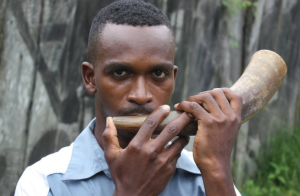Jamaica Maroons
Jamaica has several Maroon settlements of which Accompong – with around 600 residents – is the largest. Other major Maroon communities can be found in Moore Town, Scotts Hall, Trelawny Town and Charles Town. They are mostly located in the mountainous jungle region that is called ‘Cockpit Country’.
The Maroon towns are governed by elected chiefs who bear the title of ‘Colonel’. The position of “Colonel” was once a lifetime position but now has been modified to a 5 year elected position. Each Colonel is assisted by a council consisting of men and women who are appointed by him.
In total, the Jamaican Maroons make up for about 15.000 people. Some 5,000 Maroons live around Jamaica and another 10,000 or more are scattered in other countries, mostly Canada, the US and Great Britain.
Each year, the separate Maroon communities award a special day to the celebration of their history. The most important dates are:
January 6 – The Accompong Maroons celebrate Kojo Day, when the peace treaty was signed with the British.
June 23 – The Charles Town Maroons celebrate this day as their special day with activities taking place at their Asafu Yard in Portland.
August 1 – the Scott’s Hall Maroons celebrate the signing of their peace treaty with the British.
October 18 – The Moore Town Maroons celebrate Jamaica’s National Heroes Day as Nanny Day, to honor the Maroon leader.
Today, the future of the Jamaican Maroon communities and their residents is somewhat in question. Job shortages have urged many Maroons to leave their home towns and search for employment elsewhere. In addition, bauxite mining threatens to destroy the biological and cultural integrity of Cockpit Country, where the major Maroon settlements are.
Accompong
By Sharlene Hendricks, Jamaica Observer
Nestled in the hills of St Elizabeth, is the historical Maroon village called Accompong. The village was named after its founder, Accompong, who was said to be a trained Ashanti warrior from West Africa and was the brother of other Maroon leaders, Cudjoe and Nanny of the Maroons. Founded in 1739 after signing a Treaty with the British — runaway slaves led by their leader Cudjoe in defeating the local British militia, were guaranteed their freedom along with the land they had settled on. Early descendants of the original settlers had managed to retain their African heritage, which they passed on to their children and grandchildren, and to this day, their heritage has remained relatively untouched by the wider Jamaican society. For this reason, Accompong is regarded as one of the only places in Jamaica where African heritage in its purest state can be observed.
Today, Accompong is known for its annual Maroon Festival held on January 6. The festival commemorates the founding of their village, which was signalled by the Treaty signed with the British. The day is also celebrated in honour of Cudjoe, who led in the signing of the Treaty. The festival is a grand display of drumming, dancing, singing and feasting carried out by the descendants of the early Maroons who honour their ancestors in this way. Each year, patrons from all over the island as well as visitors from places ranging from Germany to Japan, flock Accompong to observe or take part in the festivities. The festival culminates with a spectacular march to the revered Kindah Tree — Kindah being an African word for One Family — with a grand finale of feasting and dancing. The settlers of Accompong do not regard themselves as citizens of the State, but as a nation within a nation.
The Abeng
The abeng, the side-blown horn, is a Maroon War Horn. It has been in use in Jamaica for over three centuries – originally was used to communicate messages between Maroon communities. It calls Maroons to assembly and to contribute to Maroon funerals. It played and still plays a major role in many other Maroon celebrations.
The abeng is made from cow horn and at full blast can be heard clearly over a distance of approximately 15 kilometers. The top of the cow horn is cut off, leaving a small opening about 1½ inches from the top end. There is also another opening over which the blower placed his mouth. The sounds are controlled with the thumb, opening and closing the small hole at the top end of the horn.
The organization Macpri describes the abeng as follows: “The abeng is believed to be an Akan word meaning “horn”. The abeng is the horn of an animal or a wind musical instrument, which is blown to produce a variety of sounds. The cow horn or the Abeng as it is called by the Maroons of Jamaica is a powerful symbol of African culture and tradition. The abeng and its blower are still very important in many communities across the African world. Before major events could begin in a community, the abeng would be blown to alert the villagers or town’s people. Depending on the sounds that came out of the instrument, the listener would be able to tell if a wedding, a birth, a death was being announced or a call to arm for an impending war. Today, ‘New World’ Africans see the symbolism of the abeng as a call to arm themselves – their minds – for them to stand up and defend their culture and traditions against extinction.”

Rodney Rose, demonstrating the abeng at Charlestown, Portland. The abeng, much like the talking drums to the native Indians, was used quite effectively by the Maroons during their many battles with their adversaries. PHOTO CREDIT: MACPRI
Maroon Observer
Click here to open this newspaper





You must be logged in to post a comment.